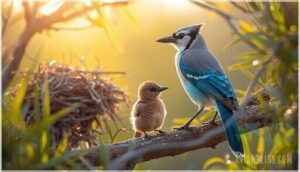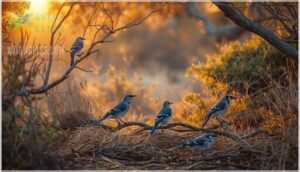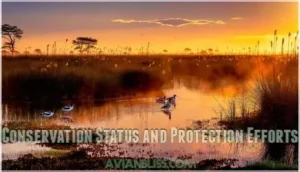This site is supported by our readers. We may earn a commission, at no cost to you, if you purchase through links.
 Among Florida’s ancient sand ridges, a blue-feathered sentinel perches on scrub oak, guarding territory its family has defended for generations. The Florida scrub jay isn’t just rare—it’s the only bird species that exists nowhere else on Earth.
Among Florida’s ancient sand ridges, a blue-feathered sentinel perches on scrub oak, guarding territory its family has defended for generations. The Florida scrub jay isn’t just rare—it’s the only bird species that exists nowhere else on Earth.
While other jays migrated and adapted across continents, this species stayed put, evolving in isolation within Florida’s scrublands for nearly two million years. Now confined to fragmented patches of habitat representing less than 10% of its historical range, this cooperative breeder faces a precarious future.
Understanding its unique adaptations, from acorn-caching strategies to family-based social structures, reveals why preserving Florida’s scrub ecosystem matters beyond saving a single species.
Table Of Contents
- Key Takeaways
- What is The Florida Scrub Jay?
- Physical Characteristics and Identification
- Habitat and Distribution in Florida
- Behavior, Diet, and Social Structure
- Conservation Status and Protection Efforts
- Frequently Asked Questions (FAQs)
- What does a Florida Scrubjay look like?
- What is a Florida Scrubjay?
- Where do scrub jay birds live in Florida?
- Where can I see a Florida scrub jay?
- Are scrub jays native to Florida?
- Is the Florida Scrubjay a endemic bird?
- What is a Florida scrub-jay?
- Is the Florida scrub-jay an endangered species?
- Where can you find a Scrubjay in Florida?
- How rare is the Florida scrub-jay?
- Conclusion
Key Takeaways
- The Florida scrub jay is North America’s only bird species confined exclusively to Florida, evolving in isolation for two million years within scrublands that now represent less than 10% of its historical range.
- Cooperative breeding defines this species’ survival strategy—family groups with helper birds produce 32% more fledglings than pairs alone, creating tight-knit units that defend 22-24 acre territories year-round without migrating.
- Population collapse tells a stark story: a 90% crash leaves roughly 7,000-11,000 individuals fragmented across isolated habitat patches, with extreme site fidelity preventing dispersal across highways or degraded landscapes.
- Prescribed fire every 5-15 years isn’t optional management—it’s the ecological lifeline that maintains scrub oak at the critical 4-5.5 foot height these birds require, while preventing habitat transformation into unusable dense forest within two decades.
What is The Florida Scrub Jay?
If you’ve ever wondered what makes the Florida Scrub Jay stand out among birds, you’re not alone. This species holds a unique place in Florida’s natural heritage, shaped by its evolutionary history and ecological role.
Let’s break down what defines this exceptional bird through its scientific classification, geographic exclusivity, and environmental importance.
Taxonomic Classification and Scientific Status
You’re looking at a bird with serious credentials. The Florida Scrub-Jay (Aphelocoma coerulescens) sits within the order Passeriformes and family Corvidae—your classic songbird with corvid smarts. Here’s what makes its taxonomy matter:
- Species Hierarchy: Elevated from subspecies status in 1995 after genetic analysis proved it wasn’t just another western scrub-jay
- Evolutionary Biology: Two million years of isolation shaped this distinct lineage
- Conservation Genetics: Federally-designated Threatened since 1987, with IUCN Status of Vulnerable reflecting its precarious position
Whole-genome sequencing revealed a 95% population crash, making taxonomy history personal. The conservation efforts for this species focus on addressing habitat loss issues.
Endemic Status and Geographic Range
Here’s the catch—this species doesn’t live anywhere else on Earth. The Florida Scrub-Jay is the state’s only endemic bird, confined to peninsular Florida’s ancient sand ridges and coastal dunes. Its geographic range spans from Flagler and Marion counties south to Collier County, but habitat fragmentation has shattered this distribution into isolated patches.
You’ll find the largest populations in Ocala National Forest and Brevard County, where conservation corridors attempt to reconnect severed landscapes. Range contraction tells a sobering story: a 90% population crash leaves roughly 7,000-11,000 birds clinging to scrublands that continue shrinking. Conservation efforts focus on preserving the native scrub habitats to protect this unique species.
Significance in Florida’s Ecosystem
This bird isn’t just surviving in Florida’s scrub—it’s holding the whole ecosystem together. Think of the Florida Scrub-Jay as nature’s maintenance crew and early warning system rolled into one:
- Ecosystem Indicator: Population health signals overall scrub habitat vitality, with fewer than 10,000 birds revealing ecosystem vulnerability
- Seed Dispersal: You’re watching a living planter—jays cache thousands of acorns annually, regenerating oak-dominated scrublands
- Fire Effects: Natural burns create the open patches these birds need, maintaining ecological balance for countless scrub-dependent species
- Restoration Role: Conservation efforts targeting jays uplift entire communities of flora and fauna, making habitat preservation a multiplier for wildlife conservation and genetic health across the Florida ecosystem
Physical Characteristics and Identification
If you’re trying to pick out a Florida Scrub-Jay from the crowd, you’ll want to know what sets this bird apart. The species has a distinctive look that makes identification straightforward once you understand the key features.
Here’s what to watch for when you’re out in the field.
Size, Shape, and Plumage Patterns
You’ll recognize the Florida Scrub-Jay by its compact, robin-sized frame, measuring 23 to 28 centimeters with a wingspan of 33 to 36 centimeters.
Adult males and females share nearly identical plumage: pale blue crowns, wings, and tails contrast with silvery gray backs and white throats bordered by blue-gray bibs.
Unlike the crested Blue Jay (Cyanocitta cristata), this species sports a sleek, crestless profile and long, rounded tail, perfect for traversing Florida’s scrubby terrain.
Distinguishing Features From Other Jays
Among Florida’s jays, you’ll spot the Aphelocoma coerulescens by what it lacks—no crest, no black neck collar, no white wing bars. Its unique plumage—pale forehead, whitish throat, and soft blue-gray pattern—sets it apart from Cyanocitta cristata.
Adult males mirror females in coloration, while harsh “shreep” vocalizations and cooperative social behavior further distinguish this endemic species from wide-ranging relatives.
Differences Between Adults and Juveniles
Plumage development reveals the story—juveniles wear dull brown feathers while adults show striking pale blue heads, wings, and tails against gray backs. By their first fall molt, young Florida Scrub-Jays shift to adult colors, joining the social hierarchy within cooperative breeding groups.
Juveniles often remain as helpers, assisting with nesting behavior and feeding behavior for younger siblings, while adult dominance structures territory defense. This bird species’ cooperative system links survival to familial bonds, though juvenile mortality remains higher during early independence phases.
Habitat and Distribution in Florida
If you’re looking to spot these striking blue-and-gray birds in the wild, you’ll need to know where they actually live. Florida scrub jays don’t just show up anywhere—they’re locked into specific habitats that have become increasingly rare.
Let’s look at the ecosystems they depend on, why fire matters more than you’d think, and where you can reliably find them.
Preferred Ecosystems and Vegetation Types
You’ll find Florida scrublands dominated by sand live oak, Chapman oak, myrtle oak, and scrub oak—species that define prime scrub-jay territory. These sandy soil ecosystems require at least 50% oak cover with medium vegetation height (4–5.5 feet), interspersed with open sand patches covering 20–50% of the ground.
Habitat fragmentation has reduced these scrub patches to isolated pockets, making ecosystem restoration critical for the Florida ScrubJay’s survival.
Role of Fire in Habitat Maintenance
Fire isn’t the enemy here—it’s the architect. Prescribed burning every 5–15 years maintains the Florida ScrubJay’s lifeline by keeping scrub oak between 4 and 5.5 feet tall. Without this burn frequency, habitat loss accelerates as unburned areas transform into dense forests within 20 years, erasing territories.
Ecosystem management through prescribed fires mimics natural fire ecology, reversing habitat fragmentation and restoring essential vegetation structure for survival.
Key Locations for Scrub Jay Observation
You’ll find the Florida Scrub Jay in protected pockets where conservation meets accessibility. Archbold Biological Station near Lake Placid monitors populations across 50 years of research, while Merritt Island National Wildlife Refuge maintains up to 3,600 individuals in prime wildlife habitat preservation zones.
- Jonathan Dickinson State Park: Southeast Florida’s largest protected Scrub Jay Reserves with marked trails
- Oscar Scherer State Park: Guided tours through observation points with 90% sighting success rates
- Ocala National Forest: Over 1,750 family groups thrive in Conservation Sites with active habitat management
- Rock Springs Run State Reserve: Translocation programs boosting populations in restored Wildlife Refuges
- Lake Okeechobee roads: County Road 731 and State Road 74 offer roadside Habitat Features for easy viewing
Behavior, Diet, and Social Structure
Florida scrub jays defy conventions regarding bird behavior—they don’t just raise their young and move on. These birds form tight-knit family units where cooperation trumps competition, and their foraging strategies reveal a surprising level of planning.
You’ll find their territorial nature and sedentary lifestyle are deeply tied to survival in Florida’s fragmented scrub habitats.
Cooperative Breeding and Family Groups
You’ll find that Florida Scrub Jay family dynamics center on cooperative behavior unlike most bird species conservation efforts highlight. Breeding success improves dramatically when helpers—usually older offspring—assist breeders with sentinel duties and nestling care.
Pairs with helpers produce 2.24 fledglings versus 1.71 without, demonstrating how group stability directly enhances avian ecology outcomes. This wildlife habitat preservation strategy depends on experienced helpers, reinforcing why family cohesion matters for species conservation.
Foraging Habits and Primary Diet
Those family helpers don’t just defend nests—they master foraging strategies that shape Florida’s scrub oak ecosystems. You’ll witness Florida Scrub-Jays spending 85% of their time hunting ground-level prey, hammering acorns with chisel-like bills, and caching 6,500–8,000 acorns each fall.
This acorn caching behavior drives seed dispersal across sand ridges, while insect predation—targeting beetles, caterpillars, and grasshoppers—regulates arthropod populations.
Dietary adaptation shifts seasonally: insects dominate spring diets at 60%, then give way to berries and small vertebrates by autumn, proving these birds excel at ornithological research-worthy resource management within their 9–15 hectare territories.
Territoriality and Non-Migratory Nature
Unlike most songbirds that migrate seasonally, you’ll find Florida Scrub-Jays locked onto territories averaging 22–24 acres year-round, defending boundaries through Sentinel Behavior and cooperative displays.
This extreme Site Fidelity—juveniles rarely disperse beyond two territory widths—makes Habitat Fragmentation devastating: isolated populations can’t relocate when fire suppression degrades their scrub oak strongholds, turning wildlife biology’s textbook Cooperative Breeding advantage into a conservation liability.
Conservation Status and Protection Efforts
The Florida Scrub Jay’s story is one of dramatic decline—and a fight to pull back from the brink. You’re looking at a species that’s lost over 90% of its original population, now clinging to fragmented patches of scrub across the state.
Here’s what’s threatening this bird, and what’s being done to save it.
Population Trends and Threats
Unfortunately, the Florida Scrub-Jay stands at a crossroads you can’t ignore. Over the past century, this threatened species has suffered roughly 90% Population Decline, dropping to approximately 7,500 individuals today—a sobering Extinction Risk that demands urgent Conservation Efforts. Habitat Fragmentation and development drive this crisis, while fire suppression transforms once-ideal scrub into overgrown thickets unsuitable for survival.
The Florida Scrub-Jay has crashed 90% to just 7,500 birds, driven to extinction’s edge by habitat loss and fire suppression
You’ll find these key threats shaping the Threat Assessment for Florida ScrubJay Conservation:
- Urban and agricultural expansion destroying native scrublands
- Fire suppression creating unsuitable dense vegetation
- Vehicle strikes causing preventable mortality
- Increased predation in degraded habitats
- Human disturbances including intentional feeding and free-roaming cats
Without coordinated wildlife preservation and Bird Conservation interventions, this endangered species faces continued decline toward functional extinction.
Impact of Habitat Loss and Fragmentation
You’re witnessing habitat destruction play out in real time across Florida’s ancient sand ridges. Fragmentation effects have carved scrub jay populations into isolated islands—males disperse just 1.6 km, females 2.8 km—leaving genetic diversity to erode in what biologists call “extinction debt.”
With fewer than 10,000 individuals clinging to habitat fragments averaging 22-24 acres per family territory, ecosystem disruption accelerates through fire suppression, roads, and agriculture.
Wildlife habitat preservation becomes your pathway to reversing this population decline before isolated groups wink out entirely.
Ongoing Conservation and Habitat Management Strategies
Beyond the grim statistics, you’ll find hope in active ecosystem management and wildlife preservation. Conservation efforts now deploy a multi-pronged approach:
- Prescribed burns on 5-year rotations maintain ideal 1.2-1.7 meter oak heights across reserve units
- Mechanical restoration expanded territories 100% at Cross Florida Greenway, supporting 145 banded jays by 2020
- Translocation programs moved 51 birds into core regions between 2003-2010, reinforcing genetic flow
- Land acquisition through Florida Forever protects 41,814 acres in Brevard’s coastal scrub ecosystem
- Legal defense partnerships between Florida Wildlife Federation and Earthjustice safeguard federal species protection
Charlotte County’s Habitat Conservation Plan channels development fees directly into habitat preservation through 2045, targeting 10,000 statewide individuals through fire-managed environmental sustainability protocols.
Frequently Asked Questions (FAQs)
What does a Florida Scrubjay look like?
The Florida Scrub-Jay sports pale blue plumage across its head, wings, and tail, contrasted by soft gray on its back and belly. Its rounded tail and crestless head shape make identification straightforward.
You’ll spot its white throat and pale forehead—key features separating it from California Scrub-Jays.
What is a Florida Scrubjay?
You’re looking at one of North America’s most exceptional corvids—a bird found nowhere else on Earth. This endemic species belongs to the genus Aphelocoma and inhabits Florida’s scrub oak ecosystems exclusively.
Its striking blue and gray plumage makes scrub jay identification straightforward in its limited range.
Where do scrub jay birds live in Florida?
Like migratory songbirds that never stray from their birthplace, you’ll find Florida scrub jay habitats locked to sandy scrublands with low-growing oaks.
These scrub jay habitat patches cluster across Central Florida and Southeast Florida, especially in conservation areas and wildlife reserves where wildlife habitat preservation efforts maintain critical Florida ecosystems.
Where can I see a Florida scrub jay?
You’ll find scrub jays at Jonathan Dickinson State Park in Southeast Florida, Lake June-in-Winter Scrub State Park in Central Florida, and Merritt Island National Wildlife Refuge.
These state parks and conservation areas protect prime scrub jay habitat—sandy scrub oak woodlands where bird watching reveals their cooperative family groups.
Are scrub jays native to Florida?
Yes—you’ll only find this scrub jay strutting around the Sunshine State. The Florida scrub jay is a true Florida endemic, meaning it evolved here and exists nowhere else on Earth. This native bird status makes it a cornerstone of bird conservation and ornithology.
Historically, scrub jays ranged across Florida’s central ridge and coastal areas, but habitat preservation challenges have isolated populations. Conservation genetics research confirms their unique evolutionary lineage within scrub jay habitat zones.
Is the Florida Scrubjay a endemic bird?
The Florida Scrub-Jay stands alone as an endemic species found exclusively within Florida’s borders—geographic isolation shaped its evolution through species adaptation.
You won’t spot this bird anywhere else on Earth, making bird conservation efforts critical for its survival as an endangered bird species.
What is a Florida scrub-jay?
What does it mean when a single bird carries the weight of an entire ecosystem on its wings? The Florida scrub-jay (Aphelocoma coerulescens) is an endemic songbird found only in peninsular Florida’s scrub habitats, distinguished by its blue and gray plumage, cooperative breeding behavior, and federally threatened conservation status.
Is the Florida scrub-jay an endangered species?
You’ll find this species listed as federally-designated Threatened rather than endangered. Habitat loss and fragmentation remain the primary threat factors driving conservation plans focused on habitat preservation and prescribed burns to guarantee species survival in remaining scrub ecosystems.
Where can you find a Scrubjay in Florida?
If you’re itching to spot these blue-and-gray songbirds in the wild, your best bet is targeting Brevard County’s Merritt Island National Wildlife Refuge and Marion County’s Ocala National Forest.
These areas are where Florida scrubjay populations thrive in protected scrub land ecosystems managed by FWC and other conservation areas focused on wildlife management.
How rare is the Florida scrub-jay?
With fewer than 10,000 individuals remaining, this Threatened Species faces extinction risk from habitat fragmentation and population decline.
The FWC and conservation efforts work to protect this vulnerable Florida scrub-jay despite a devastating 90% reduction since settlement.
Conclusion
At Oscar Scherer State Park, researchers monitored one family group for over a decade—watching helpers raise 47 fledglings across multiple generations, proof that cooperative breeding works when habitat remains intact.
Your encounters with the Florida scrub jay aren’t just birdwatching moments; they’re glimpses into evolutionary resilience under siege. These birds won’t cross highways or flee fragmented patches—they’ll defend ancestral ground until it disappears.
Protecting scrublands isn’t sentimentality; it’s acknowledging that some species would rather vanish than compromise their two-million-year legacy.









